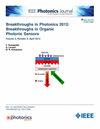量子中继辅助自由空间光通信
IF 2.4
4区 工程技术
Q3 ENGINEERING, ELECTRICAL & ELECTRONIC
引用次数: 0
摘要
基于中继的量子通信利用中间节点来延长量子信号的传输距离,减轻自由空间光信道中障碍物或湍流造成的掩蔽效应。在本研究中,我们研究了一个三节点量子通信系统,其中发送者Alice通过中间中继节点Charlie将量子编码的二进制信息发送给最终接收者Bob。通过引入Charlie,端到端传输被分成两个更短的FSO链路,提高了在严重的大气湍流和噪声存在下信号的稳定性和可靠性。这项工作提出了一种专门为FSO链路设计的量子中继方法,并根据错误概率检查了两跳中继的影响。导出Helstrom误差界限来评估系统的检测极限,同时执行密度算子计算来表征量子中继设置。此外,还得到了系统关键性能指标的封闭表达式。这些发现为优化FSO信道上长距离量子通信的量子中继策略提供了有价值的见解。本文章由计算机程序翻译,如有差异,请以英文原文为准。
Quantum Relay-Assisted Free-Space Optical Communication
Relay-based quantum communication utilizes intermediate nodes to extend the transmission distanceof quantum signals and mitigate the masking effect caused by obstacles or turbulence in free-space optical (FSO) channels. In this study, we investigate a three-node quantum communication system, where Alice, the transmitter, sends quantum-encoded binary information to Bob, the ultimate receiver, via an intermediate relay node, Charlie. By introducing Charlie, the end-to-end transmission is divided into two shorter FSO links, improving signal stability and reliability in the presence of severe atmospheric turbulence and noise. This work proposes a quantum relaying method specifically designed for FSO links and examines the impact of two-hop relaying in terms of the probability of error. The Helstrom error bound is derived to assess the system's detection limits, while density operator calculations are performed to characterize the quantum relaying setup. In addition, a closed-form expression is obtained for key system performance metrics. The findings offer valuable insights into optimizing quantum relaying strategies for long-distance quantum communication over FSO channels.
求助全文
通过发布文献求助,成功后即可免费获取论文全文。
去求助
来源期刊

IEEE Photonics Journal
ENGINEERING, ELECTRICAL & ELECTRONIC-OPTICS
CiteScore
4.50
自引率
8.30%
发文量
489
审稿时长
1.4 months
期刊介绍:
Breakthroughs in the generation of light and in its control and utilization have given rise to the field of Photonics, a rapidly expanding area of science and technology with major technological and economic impact. Photonics integrates quantum electronics and optics to accelerate progress in the generation of novel photon sources and in their utilization in emerging applications at the micro and nano scales spanning from the far-infrared/THz to the x-ray region of the electromagnetic spectrum. IEEE Photonics Journal is an online-only journal dedicated to the rapid disclosure of top-quality peer-reviewed research at the forefront of all areas of photonics. Contributions addressing issues ranging from fundamental understanding to emerging technologies and applications are within the scope of the Journal. The Journal includes topics in: Photon sources from far infrared to X-rays, Photonics materials and engineered photonic structures, Integrated optics and optoelectronic, Ultrafast, attosecond, high field and short wavelength photonics, Biophotonics, including DNA photonics, Nanophotonics, Magnetophotonics, Fundamentals of light propagation and interaction; nonlinear effects, Optical data storage, Fiber optics and optical communications devices, systems, and technologies, Micro Opto Electro Mechanical Systems (MOEMS), Microwave photonics, Optical Sensors.
 求助内容:
求助内容: 应助结果提醒方式:
应助结果提醒方式:


